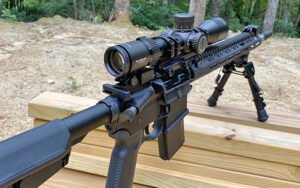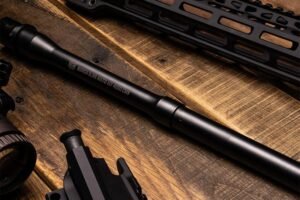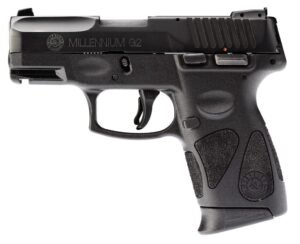Springfield Armory Prodigy Review
The Springfield Armory Prodigy (1911 DS Prodigy) brings the ‘2011’ concept double stack 1911 handgun to the masses at a comparably affordable price, and it’s quickly won our hearts as our favorite pistol for 2022 (so far).

1911s Then and Now
No pistol is more synonymous with Americana than the 1911. Since John Moses Browning introduced his masterpiece over 100 years ago, nothing has come close to replacing it as the most iconic firearm in this country, and probably the world.
That said, 100 years is a long time for anything, and by modern standards, the single action 1911 platform can come up short when measured against more modern offerings. Though it’s fair to say almost everyone can at least appreciate the 1911, many “younger” guns on the market now offer superior magazine capacity, lighter weight, easier disassembly, etc. that today’s defensive-minded shooters find preferable.
In a way, 1911s can almost be viewed as the vintage muscle cars of the handgun world. Maybe not for everyone, but there’s an undeniable cool factor. That feel of cold, heavy steel. That crisp, fast off the line single action trigger. That big ole beast of a round that is .45 ACP…drool. But it all comes at the expense of some modern day practical conveniences found in a lot of those fancy new foreign and domestic models.
1911…Meet 2011
While the 1911 was eventually adapted to accept a wider range of cartridges, shortcomings still remained, mainly ammo capacity. Enter the “2011”, a 1911 hybrid concept developed by STI/Staccato. A resto-mod, if you will, built in the look and spirit of the classic, but infused with modern improvements to give shooters some of the best of both worlds.
While the 2011 retains a lot of the metal framing of the 1911, the main difference is a grip that is replaced with molded plastic similar to modern pistols. This not only cuts some weight but also allows for double stack magazines and more modern feed system to help ensure reliability from a wider range of cartridges. What you get is a beefy, smooth-shooting handgun that laughs in the face of recoil.
So the 2011 concept isn’t new, but don’t feel bad if you’re not familiar with it. With base models ringing in at over $2000 and going up A LOT from there, the platform has been mainly off limits to all but the most serious competition shooters or aficionados. And John Wick, of course.
Until now, that is. Springfield Armory has brought the 2011 concept to the masses with their new (and comparably affordable) 1911 DS Prodigy pistol. And not only does the Prodigy measure up on paper to newer guns, Springfield Armory has added some features that takes the Prodigy far beyond many of them.
Out of the Box
But first, the basics: The Springfield Armory Prodigy is currently offered in 9mm, with a 4.25″ barreled version and full size 5″. We tested the 4.25″ Commander size for this review of the Prodigy. Each includes two magazines with capacities of 17+1 in a flush-fitting style, and 20+1 in an extended magazine respectively. An optional 26-round magazine can also be purchased. No word yet if other calibers might be coming down the pipe.
The slide, receiver and barrel for the Prodigy are made from forged steel. To parse Henry Ford’s line, you can have it any color as long as it’s black, and the Prodigy’s metal parts all feature a sleek, black Cerakote finish. The Prodigy, just like Johnny Cash, makes all black look cooler somehow.

The grip module is formed from high-impact polymer and is almost uniformly finished with a wraparound texture similar to that found on the Hellcat series. The grip has a gritty, almost sandpaper feel to it, but however you want to describe it, it provides a solid, yet tactile grip with bare hands or gloves. Empty magazines easily slide right out, and while the magwell could be a little more flared, it’s still very easy to quickly slam home a fresh magazine.
The slide’s aggressive lines and serrations help to make for almost effortless slide racking. The Prodigy is equipped with extended ambi safety levers, standard grip safety, and a witness hole so that a shooter can visually verify a that a round in chambered.
The Prodigy may have race gun DNA, but Springfield Armory made sure it’s not just a one trick pony. Both sized versions feature a lower dust cover accessory rail capable of accepting weapon lights like those made by Surefire, Streamlight, etc., to ensure the Prodigy is also usable for tactical defense or duty roles.
Another highlight for the Prodigy is the optics mounting system. Like many of today’s handguns, the Prodigy’s slide comes factory-milled for a reflex optic. But while Springfield Armory could have easily just made the Prodigy compatible with its own in-house optic, they instead smartly (and laudably) partnered with Agency Arms to incorporate its AOS mounting system.
This system features an intermediary footprint-specific plate with an integrated rear sight. This allows the shooter to purchase the plate compatible with their desired optic, install their favorite optic simply by purchasing the compatible plate. And while Springfield does include a plate that’s compatible with it’s own Hex optic, Prodigy owners aren’t limited to just that particular system.
It’s also worth noting that the iron sights, which feature a piece of hi-vis green fiber optic on the front sight blade, are tall enough to co-witness with the optic, meaning you can still shoot accurately in the case of an optic malfunction.

Springfield Armory Prodigy at the Range
There’s a lot to love about the Prodigy before even picking it up. And of course there should be when you’re talking about a $1500 gun. But at the end of the day, the thing’s got to shoot.
And shoot it does. We put the Prodigy through its paces with a variety of 9mm offerings, from our own reloads, to cheap PPU 115 FMJ range ammo and up to Federal HST +P JHP defense ammo. The Prodigy chewed through all of it without a hiccup, which is noteworthy for a model that’s commonly known to need a break-in period before cycling reliably.
Even 9mm can be snappy in some polymer guns, but returning to point of aim is almost effortless with the Prodigy. With its steel frame and heavy bull barrel, it almost seems to just want to go back to its target. If you’ve never shot a 2011 before, it quickly becomes apparent why these types of 1911s are popular with competition shooters.

The Springfield Armory Prodigy in the Real World
If we’re being honest, a standard or double-stack 1911 may not be the best choice for someone’s first handgun. 1911s are just more complicated from a maintenance and use standpoint. Not that these things can’t be overcome if your heart is set on a 1911, but for anyone starting out, we might recommend a quality striker-fired pistol available from numerous manufacturers, especially with all the hyper-modular options available these days.
That said, when the time comes for a second or third firearm, a gun like the Springfield Armory Prodigy might be a great choice. And if a potential buyer has any interest in getting into competition shooting, it’s almost a no-brainer. But more than that, the Prodigy is a feature packed gun that can take on a lot of roles, easily transitioning from competition gun to a more defense-oriented role. The same reasons that people love 2011s as a race gun also apply in tactical situations: It shoots accurately and holds a lot of bullets.
From an overall footprint standpoint, the 4.25″ Prodigy isn’t much different than say a Glock 19x, but it packs an extra half pound or so in weight. Add an optic, and maybe a light, along with that extended magazine, and it’s probably an understatement to say the Prodigy would be bit beefy for most when it comes to concealed carry. But with the right OWB holster, open carry would be quite manageable, and with that high capacity magazine, one might easily justify forgoing that extra magazine on the belt. Many have carried guns of similar size on their hip throughout history.
Obviously the same applies in the role of home defense. With the ability to mount a light, and a “small” magazine capacity that starts where many standard pistol magazines end, the Prodigy can help ensure ammo capacity never becomes a concern in a worst case scenario.
Springfield Armory spent several years developing it’s double stack 1911, and it really shows. While compared to many guns on the market, it’s high price tag may put it out of reach. But it’s almost unfair to think of it like that because the Prodigy is almost two high quality guns in one due to it’s overall versatility. From that perspective the Prodigy is almost impossible to beat from a value standpoint.
Justify it however you need to. We promise you won’t regret it.
From Springfield Armory
The Prodigy from Springfield Armory takes the proven 1911 platform and enhances it with double-stack capacity and a performance-driven feature set. Reconfigured around a double-stack magazine, the Prodigy’s polymer grip module mounts to its forged steel frame offering a capacity of 17+1. Optics ready with an ambidextrous safety and Picatinny rail, the Prodigy combines the most beloved characteristics of the 1911 with modern capacity for unrivaled performance.
Features:
- Double stack magazine design
- 1911 DS magazines are cross compatible with 2011® platforms
- Optics-Ready – AOS (Agency Optic System) plates accept most popular optics
- Single-action trigger of the 1911 has been the gold standard for over a century
- The Prodigy features a Picatinny rail on the dustcover of its frame for mounting the accessory of your choice
- Bull barrel that allows you to not only recover quickly for follow-up shots, but also get match-grade accuracy
- To allow for easy manipulation of the slide in adverse conditions, the Prodigy features generous slide serrations both front and rear
- For corrosion resistance, the Prodigy features a black Cerakote finish on its metal parts that compliments the black polymer grip module
1911 DS Prodigy Specifications:
Caliber: 9mm
Magazine Capacity: 17 rd
Barrel: Forged Stainless Steel, Match Grade, Bull, 1:16
Slide: Forged Carbon Steel, Black Cerakote, Optics-Ready
Frame: Forged Carbon Steel, Black Cerakote
Sights: Fiber Optic Front, Black Serrated Rear
Recoil System: 2 Piece Full Length Guide Rod
Safety: Extended ambidextrous frame-mounted levers
Grips: Polymer
Height: 5.5″
What is a RECCE Rifle? Meet the Longshot
US Navy Seals developed today’s Recce Rifle concept in the early 90s to bridge the tactical gap between their CQB M4s, and their larger and heavier precision rifles.
Smith & Wesson CSX Review
Smith & Wesson’s CSX joins the market of similar high capacity micro 9s while standing out from the crowd with features and flourishes not found on many competitors.
5.56 NATO VS .223 WYLDE
People new to the AR-15 can be forgiven for believing that they’re only made to fire the 5.56 NATO cartridge – the same that militaries around the world use (the NATO designation is there for a reason). They’ve also likely heard that for all intents and purposes, the 5.56 NATO and .223 Remington cartridges are pretty much…
AR-15 Pistol vs SBR. What’s the difference?
The laws that determine what takes an AR-15 from a pistol or rifle into NFA territory can be both fascinating and headache-inducing. But by keeping few rules of thumb in mind, it’s not as bad as it might seem.
Taurus G2C Review: Amazing Value or Too Good to be True?
Taurus G2C Review The Taurus PT-111 G2 has undergone a few minimal internal improvements and cosmetic changes and released back into the wild as the Taurus G2C. With many retailers offering this subcompact for around the $200 mark, it’s certainly turning a lot of heads and getting a lot of interest. Of course, one of the…






